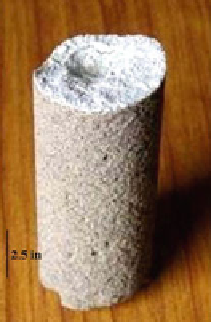Environmental Engineering Reference
In-Depth Information
Fig. 14.2 Biosandstone
(Reprinted with permission
from Achal et al.
2011a
)
sandstone cores (Jenneman et al.
1984
). The bacterial sand consolidation was
resulted into porosity reduction from sand, as reported by Kantzas et al. (
1992
)
when they found up to 50 and 90 % reduction in porosity and permeability,
respectively in sand consolidated by Bacillus pasteurii. Such reduction might be
due to high deposition of calcite in column, as Achal et al. (
2009a
) found 40 %
calcite deposition in the sand column consolidated by a mutant of Sporosarcina
pasteurii. The sand column of size 32.10 and 18.40 mm showed good amount of
compressive strength, measured up to 2 MPa (Mega Pascal) when CaCl
2
was used
as calcium source for biosandstone (Qian et al.
2010b
). The microbial induced
precipitated substance in bio-sandstone was checked using X-ray diffraction
(XRD) and energy dispersion spectroscopy (EDS), and calcite as main microbial
induced substance was seen in biosandstone (Fig.
14.3
).
The positive results of MICP on biosandstone lead researchers to think beyond
this building material i.e., sand. Researchers started focus on more complex
building material such as cement and concrete, and studied effect of MICP on the
improvement of strength, permeability and other durability parameters.
14.4.2 Microbial Concrete and Compressive Strength
Compressive strength is the first and foremost prerequisite to judge building
materials or structures, expressed as the ultimate compression load per cross
sectional area, usually in psi, Pa or Kg/cm
2
. It is required to determine whether the
concrete mixture used in construction meets the requirements of the specified
strength in the job specification or not. There are several researches on mortars,
where microbial concrete was used to enhance its compressive strength. Mortar or
cement mortar refers to a workable paste to use during construction, consisting of
cement, sand and water, while the term concrete consists of similar constituents in
addition to aggregates.

Search WWH ::

Custom Search